形容词副词用法及位置
- 格式:docx
- 大小:23.43 KB
- 文档页数:7
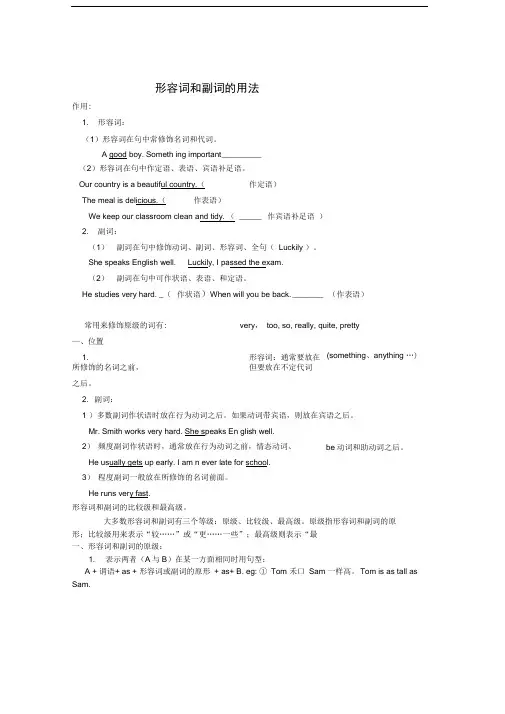
形容词和副词的用法作用:1. 形容词:(1)形容词在句中常修饰名词和代词。
A good boy. Someth ing important _________ (2)形容词在句中作定语、表语、宾语补足语。
Our country is a beautiful country.( 作定语)The meal is delicious.(作表语)We keep our classroom clean and tidy. ( _____ 作宾语补足语 ) 2. 副词:(1) 副词在句中修饰动词、副词、形容词、全句( Luckily )。
She speaks English well.Luckily, I passed the exam.(2) 副词在句中可作状语、表语、和定语。
He studies very hard. _( 作状语)When will you be back. _______ (作表语)very , too, so, really, quite, pretty—、位置1.形容词:通常要放在所修饰的名词之前, 但要放在不定代词之后。
2. 副词:1 )多数副词作状语时放在行为动词之后。
如果动词带宾语,则放在宾语之后。
Mr. Smith works very hard. She speaks En glish well. 2) 频度副词作状语时,通常放在行为动词之前,情态动词、 He usually gets up early. I am n ever late for school. 3) 程度副词一般放在所修饰的名词前面。
He runs very fast.形容词和副词的比较级和最高级。
大多数形容词和副词有三个等级:原级、比较级、最高级。
原级指形容词和副词的原形;比较级用来表示“较……”或“更……一些”;最高级则表示“最 一、形容词和副词的原级:1. 表示两者(A 与B )在某一方面相同时用句型:A + 谓语+ as + 形容词或副词的原形 + as+ B. eg: ① Tom 禾口 Sam 一样高。
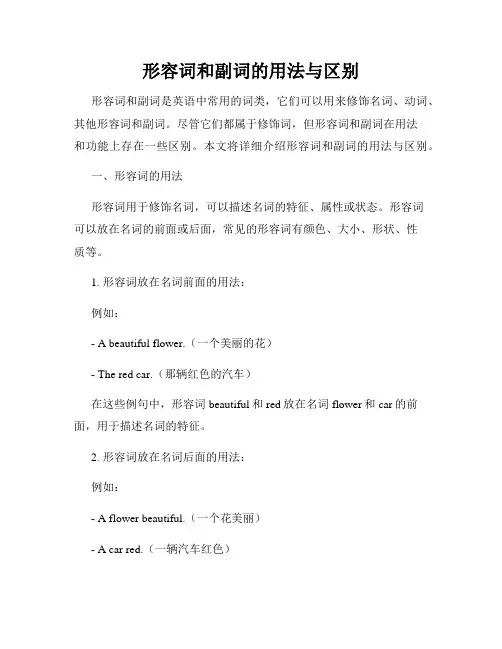
形容词和副词的用法与区别形容词和副词是英语中常用的词类,它们可以用来修饰名词、动词、其他形容词和副词。
尽管它们都属于修饰词,但形容词和副词在用法和功能上存在一些区别。
本文将详细介绍形容词和副词的用法与区别。
一、形容词的用法形容词用于修饰名词,可以描述名词的特征、属性或状态。
形容词可以放在名词的前面或后面,常见的形容词有颜色、大小、形状、性质等。
1. 形容词放在名词前面的用法:例如:- A beautiful flower.(一个美丽的花)- The red car.(那辆红色的汽车)在这些例句中,形容词beautiful和red放在名词flower和car的前面,用于描述名词的特征。
2. 形容词放在名词后面的用法:例如:- A flower beautiful.(一个花美丽)- A car red.(一辆汽车红色)在这些例句中,形容词beautiful和red放在名词flower和car的后面,也用于描述名词的特征。
除了修饰名词外,形容词还可以作为系动词(如be动词)的补语,用于描述主语。
例如:- She is happy.(她很开心)- The box is heavy.(这个盒子很重)二、副词的用法副词用于修饰动词、形容词、其他副词和整个句子,可以表示时间、地点、方式、程度等不同的语义。
副词通常放在动词后面,形容词和副词前面。
1. 修饰动词的副词用法:例如:- She runs quickly.(她跑得很快)- He speaks fluently.(他说得很流利)在这些例句中,副词quickly和fluently修饰动词runs和speaks,表示动作的方式或速度。
2. 修饰形容词的副词用法:例如:- The car is very fast.(这辆车非常快)- He is quite tall.(他相当高)在这些例句中,副词very和quite修饰形容词fast和tall,表示程度或强调。
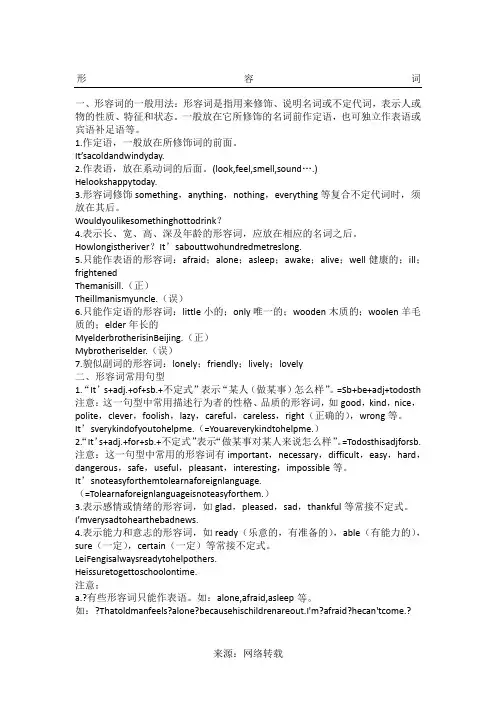
形容词一、形容词的一般用法:形容词是指用来修饰、说明名词或不定代词,表示人或物的性质、特征和状态。
一般放在它所修饰的名词前作定语,也可独立作表语或宾语补足语等。
1.作定语,一般放在所修饰词的前面。
It’sacoldandwindyday.2.作表语,放在系动词的后面。
(look,feel,smell,sound….) Helookshappytoday.I’mverysadtohearthebadnews.4.表示能力和意志的形容词,如ready(乐意的,有准备的),able(有能力的),sure(一定),certain(一定)等常接不定式。
LeiFengisalwaysreadytohelpothers.Heissuretogettoschoolontime.a.?有些形容词只能作表语。
如:alone,afraid,asleep如:?Thatoldmanfeels?alone?becausehischildrenareout.I'm?afraid?hecan'tcome.?b.?形容词与不定代词something,anything,nothing,everything等连用时,要放在这些词后面。
如:?Thereis?something?wrongwithmyDVDmachine.It's?nothing?serious.?c.?某些形容词可以和定冠词连用,表示一类人或事物,其作用相当于一个名词。
如:?theyoung(年轻人),thepoor(穷人),therich(富人)?d.?如果有两个以上的形容词修饰同一个名词时,其前后排列顺序一般如下:限定词(a/the,this/some/her……)+数量词(先序数词后基数词)+观点+大小+形状+新旧+颜色+产地+材料+名词。
如:abigoldGermancomputerⅡ副词DaiYuqiangsings?quite?well.?.副词表示频度修饰动词时,位于连系动词和助动词之后,行为动词之前。
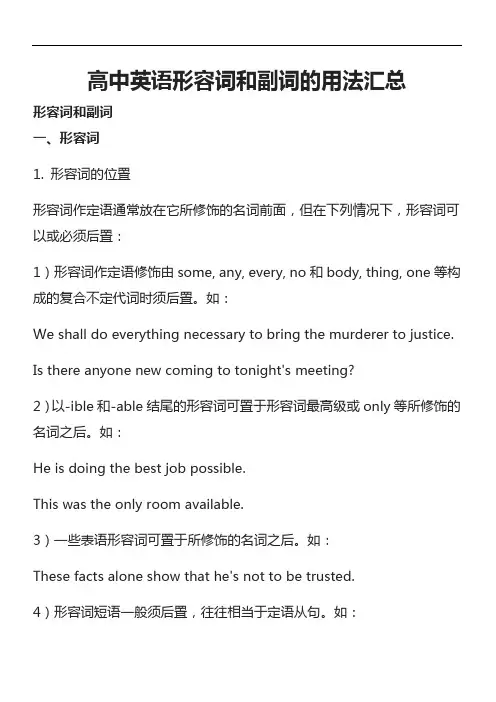
高中英语形容词和副词的用法汇总形容词和副词一、形容词1. 形容词的位置形容词作定语通常放在它所修饰的名词前面,但在下列情况下,形容词可以或必须后置:1)形容词作定语修饰由some, any, every, no和body, thing, one等构成的复合不定代词时须后置。
如:We shall do everything necessary to bring the murderer to justice.Is there anyone new coming to tonight's meeting?2)以-ible和-able结尾的形容词可置于形容词最高级或only等所修饰的名词之后。
如:He is doing the best job possible.This was the only room available.3)一些表语形容词可置于所修饰的名词之后。
如:These facts alone show that he's not to be trusted.4)形容词短语一般须后置,往往相当于定语从句。
如:He was a king anxious for his people's welfare.2. 前置形容词的排列顺序多个形容词修饰名词时,它们的顺序大致为:描绘性形容词(短词在前,长词在后)→表特征的形容词(包括大小、形状、新旧、年龄等,顺序也大致如此,但不固定)→表颜色的形容词→表类属的形容词(包括专有形容词和表材料质地的形容词)。
如:the beautiful little white Chinese bridgea tall intelligent young British officer二、副词1. 副词的分类副词大体上可分为下面几类:1)时间副词,如before, early, now。
2)地点副词,如everywhere, there, here。
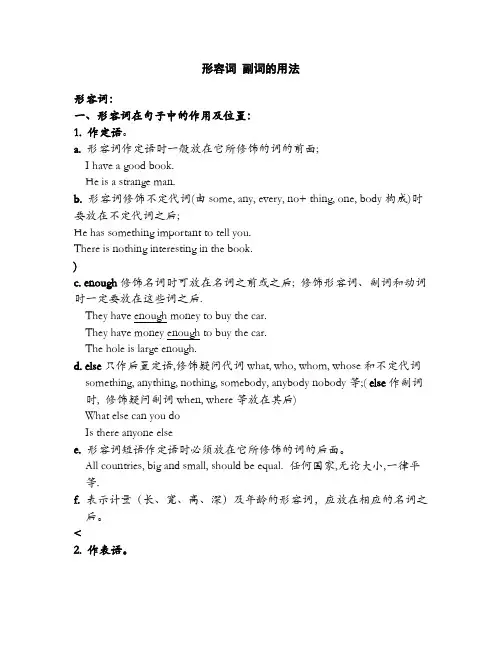
形容词 副词的用法形容词: 一、形容词在句子中的作用及位置: 1. 作定语。
a. 形容词作定语时一般放在它所修饰的词的前面;I have a good book. He is a strange man. b. 形容词修饰不定代词(由 some, any, every, no+ thing, one, body 构成)时 要放在不定代词之后; He has something important to tell you. There is nothing interesting in the book. ) c. enough 修饰名词时可放在名词之前或之后; 修饰形容词、副词和动词 时一定要放在这些词之后. They have enough money to buy the car. They have money enough to buy the car. The hole is large enough. d. else 只作后置定语,修饰疑问代词 what, who, whom, whose 和不定代词 something, anything, nothing, somebody, anybody nobody 等;( else 作副词 时, 修饰疑问副词 when, where 等放在其后) What else can you do Is there anyone else e. 形容词短语作定语时必须放在它所修饰的词的后面。
All countries, big and small, should be equal. 任何国家,无论大小,一律平 等. f. 表示计量(长、宽、高、深)及年龄的形容词,应放在相应的名词之 后。
< 2. 作表语。
在系动词和半系动词 feel(感到),look(看起来),sound(听起来), smell(闻起来),taste(尝起来),become(变成)get(变成),turn (变成),fall(变成), seem(似乎,好象)后,用形容词作表语。
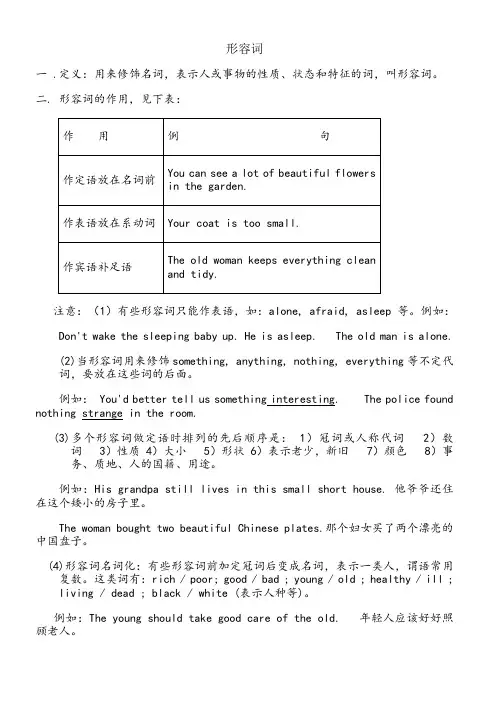
形容词一 .定义:用来修饰名词,表示人或事物的性质、状态和特征的词,叫形容词。
二. 形容词的作用,见下表:注意:(1)有些形容词只能作表语,如:alone, afraid, asleep 等。
例如:Don't wake the sleeping baby up. He is asleep. The old man is alone.(2)当形容词用来修饰something, anything, nothing, everything等不定代词,要放在这些词的后面。
例如: You'd better tell us something interesting. The police found nothing strange in the room.(3)多个形容词做定语时排列的先后顺序是: 1)冠词或人称代词 2)数词 3)性质 4)大小 5)形状 6)表示老少,新旧 7)颜色 8)事务、质地、人的国籍、用途。
例如:His grandpa still lives in this small short house. 他爷爷还住在这个矮小的房子里。
The woman bought two beautiful Chinese plates.那个妇女买了两个漂亮的中国盘子。
(4)形容词名词化:有些形容词前加定冠词后变成名词,表示一类人,谓语常用复数。
这类词有:rich / poor; good / bad ; young / old ; healthy / ill ;living / dead ; black / white (表示人种等)。
例如:The young should take good care of the old. 年轻人应该好好照顾老人。
三.以-ly结尾的形容词1)大部分形容词加-ly可构成副词。
但 friendly,deadly,lovely,lonely,likely,lively,ugly,brotherly,仍为形容词。
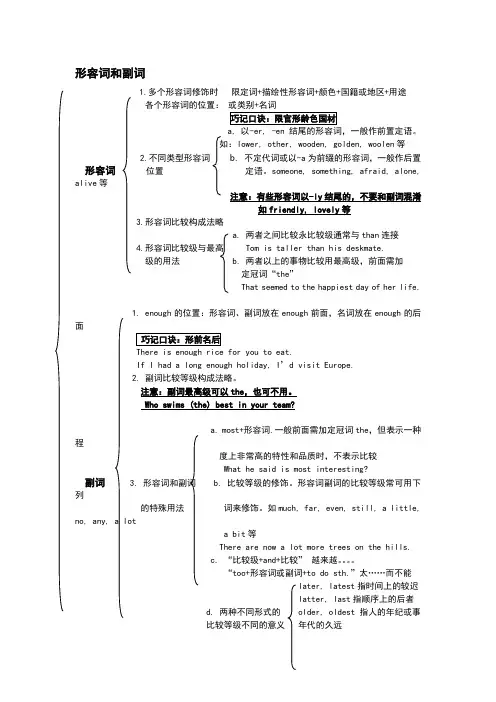
形容词和副词1.多个形容词修饰时限定词+描绘性形容词+颜色+国籍或地区+用途各个形容词的位置:或类别+名词a, 以-er, -en结尾的形容词,一般作前置定语。
如:lower, other, wooden, golden, woolen等2.不同类型形容词 b.不定代词或以-a为前缀的形容词,一般作后置形容词位置定语。
someone, something, afraid, alone, alive等注意:有些形容词以-ly结尾的,不要和副词混淆如friendly, lovely等3.形容词比较构成法略a. 两者之间比较永比较级通常与than连接4.形容词比较级与最高 Tom is taller than his deskmate.级的用法 b. 两者以上的事物比较用最高级,前面需加定冠词“the”That seemed to the happiest day of her life.1. enough的位置:形容词、副词放在enough前面,名词放在enough的后面There is enough rice for you to eat.If I had a long enough holiday, I’d visit Europe.2. 副词比较等级构成法略。
注意:副词最高级可以the,也可不用。
Who swims (the) best in your team?a. most+形容词.一般前面需加定冠词the,但表示一种程度上非常高的特性和品质时,不表示比较What he said is most interesting?副词 3. 形容词和副词 b. 比较等级的修饰。
形容词副词的比较等级常可用下列的特殊用法词来修饰。
如much, far, even, still, a little, no, any, a lota bit等There are now a lot more trees on the hills.c. “比较级+and+比较”越来越。

形容词和副词的知识点归纳一、形容词。
1. 定义与作用。
- 形容词主要用来描写或修饰名词或代词,表示人或事物的性质、状态、特征或属性。
例如:“a beautiful flower”(美丽的花朵),“beautiful”修饰名词“flower”,描述花的特征。
2. 形容词的位置。
- 前置修饰:- 一般情况下,形容词位于名词之前,作定语。
如:“a tall boy”(一个高个子男孩)。
- 当有多个形容词修饰同一个名词时,存在一定的顺序:限定词(如a, an, the 等)+描绘性形容词(如beautiful, nice等)+大小、长短、高低等形容词(如big, small等)+形状形容词(如round, square等)+年龄、新旧形容词(如new, old 等)+颜色形容词(如red, blue等)+国籍、地区形容词(如Chinese, American 等)+材料形容词(如wooden, plastic等)+用途、类别形容词(如writing, reading等)。
例如:“a beautiful small round new red Chinese woodenwriting desk”(一张漂亮的、小的、圆的、新的、红色的、中国的、木制的写字台)。
- 后置修饰:- 当形容词修饰不定代词(something, anything, nothing等)时,形容词后置。
例如:“There is something important to tell you.”(有一些重要的事情要告诉你)。
- 在一些固定结构中,形容词后置,如“the people present”(在场的人)。
3. 形容词的比较级和最高级。
- 规则变化:- 一般在词尾加 -er(比较级)和 -est(最高级)。
如:tall - taller - tallest。
- 以不发音的e结尾的单词,加 -r和 -st。
如:nice - nicer - nicest。

形容词和副词用法&广东高考一、形容词1. 形容词的位置:修饰语一般应置于被修饰语之前注意:在下列情况下,修饰语应置于被修饰的名词后:(1) something, anything, nothing everything +形容词。
Eg: There' s nothing wrong with the electric cooker.(2) 作定语用的分词短语Eg: They live in a village called Gum Tree.2. 形容词在句子中的成分(1).在名词之前修饰名词,作定语•Eg: a. There are many beautiful flowers in the park. b. We saw a moving film.(2).在be 动词后,或者系动词feel, look, sou nd, taste, smell, seem 后,作表语.Eg: a. Our school is new and big. b. The milk smells terrible, it seems bad。
(3) 在宾语后作宾语补足语.:think/find/ feel/ make + it (形宾)+ adj. +真正的宾语Eg: a. We all think it terrible to go through such an experienee.b. He ofte n makes his mother an gry.3. 在英语中有些表示“使人….”的动词,把其变成现在分词或过去分词当形容词使用。
其中现在分词~ing形式表示“令人...... "修饰物;过去副词~ed形式修饰人(被动),这一类动词如下:In terest, excite, thrill, surprise, shock, amaze,ast oni sh, amuse, please, annoy, con fuse, upset, concern, worry, move, touch, satisfy, disappo in t, i nspire, en courage, etc.a/ an/ the + 形容词+名词be / 系动词(look/sound/ taste/ smell/ feel / seem/stay/ keep ….)+ 形容词主语+谓语+宾语+形容词(宾补)EX: Fill in the bla nks with the right form of the give n words.1. That would be a very ___________ (reason) thing to do in a big city.2. Mary felt _____________ (please) because there were many emtpy seats in the room.3. This proverb is saying we habve to let things go in their _____________ (nature) course.4. It was a little far to her car and it was a _____________ (fog) day yesterday.5. The _________ (busy) time is aroudn the Spring Festival.6. The organization organizes _____________ (week) programs at the Skateistan Cambodia.7. Asimov'books cover _____________ (vary) topics in scie nee.8. The terrible film made the girl stay ___________ (wake) all the night.9. Her mother looked ____________ (worry) and she sat still there for a long time.10. People are very _____________ (friend) and always welcome visitors all over the world.、副词1、副词的位置及作用:通常作状语,可修饰动词,形容词或整个句子。
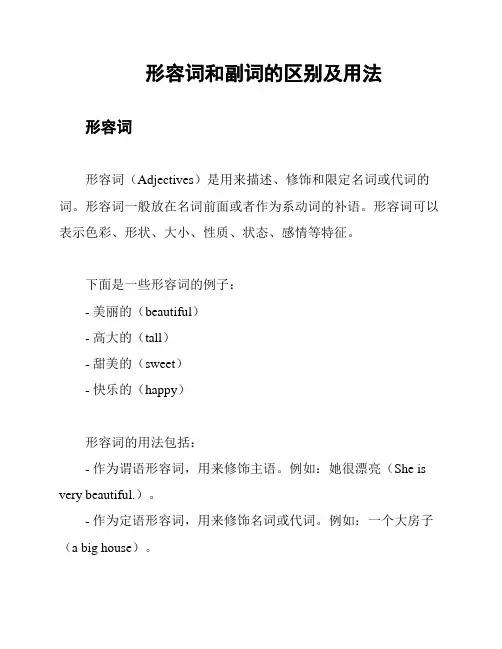
形容词和副词的区别及用法形容词形容词(Adjectives)是用来描述、修饰和限定名词或代词的词。
形容词一般放在名词前面或者作为系动词的补语。
形容词可以表示色彩、形状、大小、性质、状态、感情等特征。
下面是一些形容词的例子:- 美丽的(beautiful)- 高大的(tall)- 甜美的(sweet)- 快乐的(happy)形容词的用法包括:- 作为谓语形容词,用来修饰主语。
例如:她很漂亮(She is very beautiful.)。
- 作为定语形容词,用来修饰名词或代词。
例如:一个大房子(a big house)。
- 作为补语形容词,用来修饰系动词,并与主语有关系。
例如:他很累(He is tired.)。
副词副词(Adverbs)是用来修饰动词、形容词、副词和句子的词。
副词可以表示方式、时间、地点、程度、目的等。
副词一般放在动词、形容词或其他副词前面。
下面是一些副词的例子:- 快速地(quickly)- 非常(very)- 现在(now)- 安静地(quietly)副词的用法包括:- 修饰动词,表示动作的方式、程度、频率等。
例如:他跑得很快(He runs quickly.)。
- 修饰形容词,表示形容词的程度。
例如:这本书很好看(This book is very interesting.)。
- 修饰其他副词,表示副词的程度。
例如:他跑得非常迅速(He runs extremely fast.)。
- 修饰整个句子,表示说话者的态度、时间、地点等。
例如:幸好你来了(Luckily, you came.)。
形容词和副词的区别形容词和副词的主要区别在于它们修饰的词不同。
形容词修饰名词或代词,而副词修饰动词、形容词、副词和句子。
此外,形容词在句子中常常作为定语或谓语使用,而副词在句子中常常作为状语使用。
下面是一些形容词和副词的对比例子:- 形容词:这个小女孩很聪明(The little girl is very smart.)- 副词:她跑得很快(She runs very quickly.)总结形容词和副词在英语中扮演了重要的角色,用来描述、修饰和限定其他词或句子。
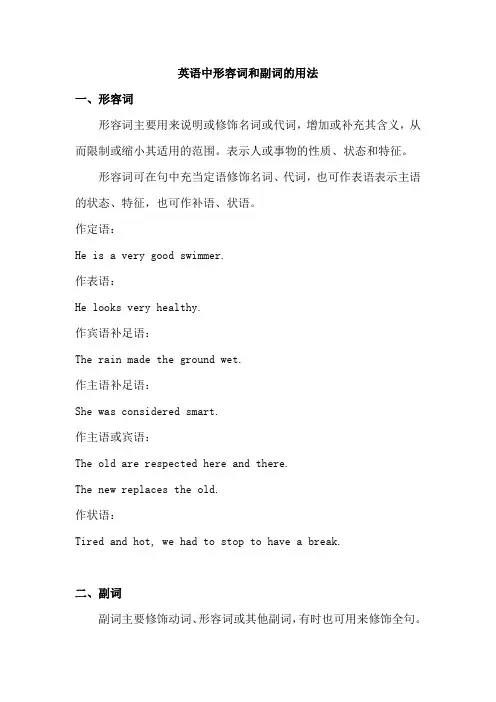
英语中形容词和副词的用法一、形容词形容词主要用来说明或修饰名词或代词,增加或补充其含义,从而限制或缩小其适用的范围。
表示人或事物的性质、状态和特征。
形容词可在句中充当定语修饰名词、代词,也可作表语表示主语的状态、特征,也可作补语、状语。
作定语:He is a very good swimmer.作表语:He looks very healthy.作宾语补足语:The rain made the ground wet.作主语补足语:She was considered smart.作主语或宾语:The old are respected here and there.The new replaces the old.作状语:Tired and hot, we had to stop to have a break.二、副词副词主要修饰动词、形容词或其他副词,有时也可用来修饰全句。
说明时间、地点、方式、程度等概念。
作状语:It's raining heavily.修饰形容词:It's rather a difficult job.修饰介词短语:The arrow hit the apple right in the middle.修饰从句:This is exactly what she said.修饰名词、代词及数词:Life here is full of joy.She is going to extend her stay there for about two weeks. Nearly everybody came to party.作表语:The class is over.作介词宾语:Who is calling me from downstairs?作定语:Are you content with the life here?作补语:We were shown by the young man.。
形容词副词用法总结形容词和副词都用来修饰名词或代词,但是形容词更多地用于修饰名词,而副词更多地用于修饰动词。
一、形容词:1、形容词通常位于名词之前,有时也可以位于“be动词”或“感官动词”之后,以及介词之后,例如:He is handsome.That dress looks beautiful.She is intelligent in math.2、形容词的比较级和最高级:后缀加-er/-est来构成比较级和最高级,当一个形容词有两个音节或者更多音节,需要用more/most来构成比较级和最高级形式,例:tall-taller-the tallestbeautiful-more beautiful-most beautiful3、形容词的反义词:具有反义关系的形容词可以直接用前缀un-来表示反义,例:happy-(un)-happy4、形容词的最高级的格式:形容词最高级的表达形式是“the +原级+ of/in +名词”,当名词前面提到的只有2个,可以不用of,例如:He is the tallest boy of the three.She is the prettiest girl in the class.二、副词:1、副词通常用来修饰整句,最常见的形式有“副词+动词”,例:She speaks quickly.2、副词的比较级和最高级:副词比较级和最高级一般通过-er和-est来构成,但也有些特殊情况,例如“good-better-best”;当副词有三个或者更多音节时,需要用more/most来构成比较级和最高级形式,例:carefully-more carefully-most carefully3、副词的最高级的格式:副词最高级的表达形式一般是“the +副词+ of/in +名词”,当名词前面提到的只有2个,可以不用of,例如:He runs the fastest of all.She dances the most beautifully in the party.。
新王牌闵行校区高中王A老师资料高中英语语法知识系列形容词和副词形容词可用于作表语、定语、宾语补足语、状语等;副词也可以作表语、定语、宾语补足语、状语等。
一.形容词作定语时的位置大部分形容词作定语时放在所修饰的名词前面, 如 a red bus, a beautiful park, cold weather等, 但实际运用时须注意以下情况。
1.当多个形容词修饰一个名词时应该注意形容词的一般排列顺序。
“限数描大小、形龄新旧色、国材用途类”例如:his beautiful small round old brown French wooden writing table当然,在实际运用中用如此多的形容词修饰一个名词并不多见。
2.形容词修饰everything, something, anything, nothing时, 只能放在其后面。
如:Some farmers saw something strange in the sky.There is nothing interesting at all.3.else只能修饰疑问代词who, whom, whose, what和不定代词something, anything, nothing, somebody, someone, anybody, anyone和nobody, no one.而且只能放在其后。
如: Is there anything else you want to say? What else do you want?else与上述疑问代词和不定代词构成所有格时, 只能在else后加's, 而不能在疑问代词或不定代词后加's. 如说someone else's, 而不能说someone’s else;who else的所有格有两种形式who else's或whose else例如:— Is this hat yours? — Whose else ( =Who else's) could it be ?4.enough和nearby作形容词时可放在所修饰的名词前,也可放在其后。
语法要点形容词和副词语法要点:形容词和副词形容词和副词是英语中常用的词性,它们在句子中用于修饰名词或者动词,起到描述事物和说明动作状态的作用。
本文将详细介绍形容词和副词的用法及相关要点。
一、形容词的基本用法1. 形容词修饰名词形容词可以单独或者连用来修饰名词,表达事物的性质、特征、状态等。
例如:- A beautiful flower.(一个美丽的花)- The tall building.(那座高大的建筑)- Some delicious food.(一些美味的食物)2. 形容词的比较级和最高级形容词有比较级和最高级两种形式,用于比较两个或多个事物的大小、程度、高低等差异。
比较级一般用于两者之间的比较,最高级用于三者或三者以上的比较。
构成比较级和最高级的规则如下:- 单音节形容词 + -er(比较级)/ -est(最高级);如:big(大)- bigger(更大)- biggest(最大)- 以“e”结尾的形容词 + -r(比较级)/ -st(最高级);如:large(大)- larger(更大)- largest(最大)- 以辅音字母+y结尾的形容词,去y变i + -er(比较级)/ -est(最高级);如:happy(开心的)- happier(更开心的)- happiest(最开心的)- 重读闭音节形容词,且末尾只有一个辅音字母,双写该辅音字母+ -er(比较级)/ -est(最高级);如:big(大)- bigger(更大)- biggest(最大)3. 形容词的位置形容词一般位于名词之前,有时也可位于系动词之后作表语。
例如:- She is a beautiful girl.(她是一个美丽的女孩)- The book is interesting.(这本书很有趣)二、副词的基本用法1. 副词修饰动词副词用来修饰动词,表示动作的方式、频率、时间等。
例如:- He speaks English fluently.(他流利地讲英语)- We often go to the park on weekends.(我们经常在周末去公园)2. 副词修饰形容词或者副词副词可以用来修饰形容词或者副词,表示程度、方式等。
形容词讲解形容词主要是用来描述和修饰名词、代词,用来说明其大小、形状、颜色等具体特征,也可用来陈述事物的状态等。
一.常见的形容词形式二. 形容词的句法功能三.形容词的位置1.置于名词前:形容词作定语一般位于名词前。
如:They are all my best friends.There is an empty cup on the table.2. 形容词在修饰someone, somebody, something, anyone, anybody, nothing等不定代词时,需要置于其后。
如:I've something important to tell you.'There's nothing serious with him.3.多个形容词修饰名词时的排列顺序多个形容词修饰一个名词时,其排列顺序通常如下:限定词(包括冠词、所有格、人称代词、数量词等)+大小+形状+性质或状态+年龄或新旧+材料或种类+来源+名词。
如:There are a few round black tables in the room.I’ll always remember the unforgettable sunny days.四.形容词的比较级和最高级1.比较级和最高级的构成most interesting2.比较等级的用法1)两者程度相同的比较a.as+形容词原级+as如:My handwriting is as beautiful as yours.This book is as interesting as that one.b.not as/so as如:I am not as busy as you.Tom is not so bright as his brother.2)高于或低于另一方的比较比较级+than如:You look much younger than me.The weather in Beijing is drier than that in Nanjing.3)比较级+and+比较级这种结构表示事物本身程度的逐渐增长,意为“越来越……”如:Our country is becoming more and more beautiful.As summer is coming, the day is becoming hotter and hotter.4)the+比较级…,the+比较级…这种结构用来表示一方的程度随着另一方的程度的增长而增长,意为“越…越…”如:The more you eat, the fatter you will be.The shorter your talk is, the better it is.3. 最高级的用法. 表示在三者或三者以上中程度最高the+形容词最高级+名词+表示范围的短语或从句如:Jack is the tallest student in his class.He is the best runner in the team.4.比较级和最高级的修饰语1)修饰比较级的常用语和短语主要有much,even,a lot, a little等。
考点一形容词和副词的基本用法
一、形容词的用法及位置
说明人或事物的特征、性质或状态,常用来修饰名词和不定代词的词叫形容词。
1.作定语放在名词前,复合不定代词之后。
如:
The nice girl is my sister.
I have something important to tell you.
2.做表语放在系动词之后。
She is so beautiful.
He looks very happy.
3.作宾补,放在宾语之后,常与make,leave,keep等动词连用。
如:
You must keep the classroom cleaned.
We should make our city more beautiful.
二、常见名词变形容词方法
三、副词的功能
1.作状语
He works hard.
He parked car very easily.
2.作表语
做表语的副词多数是表示位置或状态的,入in, out, on, down, up, off, away, upstairs.
He is in.
What’s on this evening?
3.作宾语补足语
Let them in.
四、副词的分类
1. 时间副词
时间副词要有now, then, today, tomorrow, yesterday, before, soon, lately, already, just等。
时间副词是确定句子时态的重要标志,所以一定要牢固掌握不同时态的时间标志。
2. 地点副词
地点副词有outside, inside, upstairs, here, there, home, near, away, in , back, off, up, anywhere等。
地点副词和动词连用时,不加介词。
3. 方式副词
方式副词有quickly,happily,loudly,suddenly,badly,easily,fast等。
方式副词大多由“形容词+ly”构成。
4. 程度副词
程度副词有very,quite,rather,too,much,so等。
有些程度副词可以修饰形容词、副词的原级,有些能修饰形容词、副词的比较级。
5. 疑问副词
疑问副词有when,where,why,how,how long,how soon,how often等。
疑问副词常用来构成特殊疑问句。
6. 关系副词
关系副词有when,where,why。
关系副词常用来引导定语从句。
7. 频度副词
频度副词有often,usually,never等。
考点二形容词(副词)的比较等级
一、形容词(副词)原级的用法
1、一些副词如very,so,too,enough,quite等修饰形容词或副词的原级。
如;
The boy is too young.
2、表示A与B在某方面程度相同或者不同时用形容词(副词)的原级。
(1)肯定句中的结构:“A…+as+形容词(副词)的原级+ as + B”
English is as interesting as Chinese.
Li Lei runs as fast as Li Hua.
(2)否定句中的结构:“A…+ not + as/so + 形容词(副词)原级+ as + B”
This book isn’t so new as that one.
I can’t type as/so fast as my brother.
(3)否定句的结构中,部分双音节和多音节形容词(副词)除使用“not…as/so+ 形容词(副词)原级+ as”的结构外,还可以使用“less+形容词(副词)原级+than”的结构
He thinks Chinese is less interesting than English.
(4)表示“A是B的……倍”时,用“A…+ 倍数 + as + 形容词(副词)原级+ as + B”结构。
(一倍:once,两倍:twice,三倍及以上:基数词+times) Our school is three times as big as theirs.
(5)half as + 形容词(副词)原级 + as 表示“……是……的一半”
Her room is half as big as yours.
二、形容词比较级的用法(副词比较级的用法与形容词基本相同)
(一)形容词比较等级的构成
1. 表示两者进行比较时用形容词比较级,其结构为“A…+比较级+than+B”。
如:Lily‘s room is bigger than mine.
注意:为了避免重复,常用the one, that, those 等词来代替前面出现过的名词。
其中the one代替可数名词单数形式,the ones代替可数名词复数形式,that 代替单数名词或不可数名词。
如: the weather of Shenyang is colder thanthat of Shanghai.
2.有表示程度的副词,a little, a bit, a great deal, a lot, much, even, still, far等修饰形容词时,该形容词可以用比较级。
如:it’s much colder thanyesterday.
3. 表示两者之间进行选择“哪一个更······”时,用句型“which/who+be+形容词比较级,A or B?” 表示。
Who is taller, Tom or Jack?
4. 表示倍数时,用“倍数+比较级+than”表示。
如:Your room is three times bigger than mine.
5. 表示“两者之间比较······的一个(of the two)”时,常用“the+比较级” 结构。
Mary is the taller of the twins.
6. 表示“越来越······” 用比较级重叠结构,即“比较级+and+比较级”,当形容词为多音节词或部分双音节词时,用“more and more+形容词比较级”。
It’s getting colder and colder in winter
7. 表示“越······越······”时,用“the+比较级,the+ 比较级”结构。
The more,the better.
三、形容词最高级的用法(副词最高级的用法与形容词基本相同)
1.表示三者或三者以上的人或物进行比较时,用最高级形式。
形容词最高级前一般加定冠词the,句末常跟一个in或of短语来表示范围。
Shanghai is the biggest city in China.
2.表示在三者或三者以上的人或物中进行选择时,用“which/who+ be +the +形容词最高级,A,B or C?”结构。
Which city is the most beautiful, Beijing, Shanghai or Fuzhou?
3. 表示“最······的······之一”时,用“one of the+ 形容词最高级+可数名词复数” 结构。
Jay Chou is one of the most famous singers.
4. 形容词最高级前面可以加序数词,表示“第几最······”
The yellow river is one of the second longest river in China.
5. 形容词最高级前面可以用物主代词、指示代词、名词所有格修饰,此时不能再用定冠词。
This is our best lesson today。
考点三形容词和副词词义辨析一、-ing形容词和-ed 形容词。
二、几组易混副词(短语)。